Skin
Skin | Dr. Mahmood Yunus Usmani
Skin Disorders
Dermatological rejuvenation procedures
- Ring Worm
- Fungus Infection
- Boil
- Furunculosis
- Scabies
- Acne Vulgaris
- Urticaria
- Psoriasis
- Ichthyosis
- Chapped hand
- Seborrhoea
- Pruritus
- Heat Rashes
- Ecchymosis
- Cuts
- Vitiligo
- Herpes infection
- Freckles
- Molluscum
- Wart
- Corn
- Tinea Versicolor
- Tinea Cruris
- Alopecia
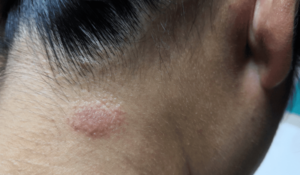
Ringworm, or tinea corporis, is a common fungal skin infection characterized by circular, red, and scaly rashes. Despite its name, it is not caused by a worm.
Causes:
Ringworm is caused by dermatophyte fungi, which thrive in warm, moist environments. The infection spreads through:
Direct skin-to-skin contact with an infected person or animal.
Contact with contaminated objects like towels, clothing, or surfaces.
Exposure to infected soil.
Risk factors include excessive sweating, wearing tight clothing, and having a weakened immune system.
Symptoms:
Symptoms typically appear 4–14 days after exposure and include:
Itchy, red, circular rashes with raised edges and a clearer center.
Scaly or cracked skin in the affected area.
Hair loss if the scalp is involved.
The rash may expand over time and can appear on various body parts, including the arms, legs, torso, and face.
Prevention:
To prevent ringworm:
Maintain good hygiene by keeping skin clean and dry.
Avoid sharing personal items like towels, clothing, or hairbrushes.
Wear breathable clothing and change out of sweaty clothes promptly.
Use protective footwear in communal areas like locker rooms or pools.
Regularly clean and disinfect shared surfaces and equipment.
If you notice symptoms of ringworm, consult a healthcare professional for accurate diagnosis and appropriate management.
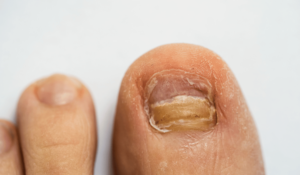
Fungal skin infections, or dermatomycoses, are common conditions caused by various fungi that thrive in warm, moist environments. These infections can affect different parts of the body, leading to discomfort and skin changes.
Causes:
Fungi responsible for these infections include dermatophytes, yeasts, and molds. They can be transmitted through:
Direct Contact: Touching an infected person or animal.
Indirect Contact: Using contaminated items like towels, clothing, or surfaces.
Factors increasing susceptibility include excessive sweating, tight clothing, compromised immunity, and poor hygiene.
Symptoms:
Symptoms vary based on the infection’s location and type but commonly include:
Red, Itchy Rash: Often with a scaly or cracked appearance.
Ring-Shaped Lesions: Characteristic of ringworm.
Peeling or Flaking Skin: Especially between toes or in skin folds.
Discoloration: Patches that may be lighter or darker than surrounding skin.
Prevention:
To minimize the risk of fungal skin infections:
Maintain Hygiene: Keep skin clean and dry, especially in areas prone to moisture.
Wear Breathable Clothing: Opt for loose-fitting, natural fabrics.
Avoid Sharing Personal Items: Do not share towels, clothing, or grooming tools.
Use Protective Footwear: Wear sandals or shoes in communal areas like gyms or pools.
If you experience persistent or worsening symptoms, consult a healthcare professional for accurate diagnosis and appropriate management.
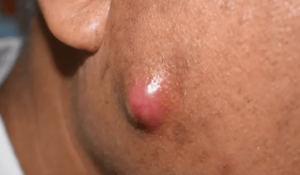
A boil, or furuncle, is a painful, pus-filled bump under the skin caused by bacterial infection, typically Staphylococcus aureus. It begins as a red, tender area that becomes firm and swollen, eventually developing a white or yellow center as pus accumulates. Boils commonly appear in hair-bearing regions prone to friction and moisture, such as the neck, armpits, face, thighs, and buttocks.
Causes:
Boils result from bacteria entering the skin through hair follicles or minor cuts. Risk factors include poor hygiene, close contact with infected individuals, compromised immunity, diabetes, and skin conditions like eczema.
Symptoms:
Red, swollen, tender lump
Pus-filled center
Pain intensifying until drainage
Possible fever or swollen lymph nodes in severe cases
Clusters of boils, known as carbuncles, may cause deeper infections and scarring.
Prevention:
Maintain good personal hygiene
Keep skin clean and dry
Avoid sharing personal items
Wear loose-fitting clothing
Manage underlying health conditions
If boils recur or worsen, consult a healthcare professional for proper diagnosis and management.
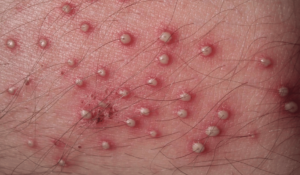
Furunculosis is a condition characterized by the development of multiple or recurrent boils, known as furuncles. These are painful, pus-filled nodules that form due to deep bacterial infections of hair follicles.
Causes:
Furunculosis is primarily caused by the bacterium Staphylococcus aureus, which infects hair follicles. Risk factors include close contact with infected individuals, compromised immune function, poor hygiene, diabetes, and other underlying health conditions.
Symptoms:
Furuncles present as red, tender lumps that increase in size and become more painful over time. The center of the boil fills with pus, forming a white or yellow head. In cases of furunculosis, multiple boils may develop simultaneously or sequentially, sometimes merging to form larger clusters called carbuncles. Systemic symptoms such as fever and swollen lymph nodes may also occur.
Prevention:
To reduce the risk of furunculosis:
Maintain good personal hygiene by regularly washing the skin with soap and water.
Avoid sharing personal items such as towels, razors, or clothing.
Properly clean and cover any cuts or abrasions to prevent bacterial entry.
Manage underlying health conditions and support immune function through a balanced diet and healthy lifestyle.
If boils recur frequently or are accompanied by systemic symptoms, consult a healthcare professional for further evaluation and management.
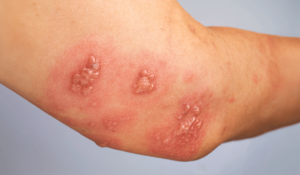
Scabies is a highly contagious skin condition caused by the Sarcoptes scabiei mite, which burrows into the skin, leading to intense itching and a pimple-like rash.
Causes:
Scabies spreads primarily through prolonged skin-to-skin contact with an infected person. Sharing personal items like clothing, bedding, or towels can also facilitate transmission, though this is less common. Crowded living conditions and close physical interactions increase the risk of infestation.
Symptoms:
The hallmark symptoms include severe itching, especially at night, and a rash resembling small red bumps or blisters. Commonly affected areas are between the fingers, wrists, elbows, armpits, waist, buttocks, and genital region. In infants and young children, the head, face, neck, palms, and soles may also be involved.
Prevention:
To prevent scabies:
Avoid prolonged skin-to-skin contact with infected individuals.
Refrain from sharing personal items such as clothing, bedding, and towels.
Maintain good personal hygiene and regular laundering of clothes and linens.
If symptoms persist after treatment or new lesions appear, consult a healthcare professional for further evaluation and management.
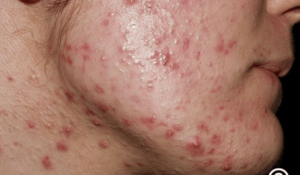
Acne vulgaris, commonly known as acne, is a prevalent skin condition characterized by the blockage of hair follicles due to excess oil (sebum), dead skin cells, and bacteria. This leads to various lesions primarily on the face, chest, back, and shoulders.
Causes:
Acne develops when hair follicles become clogged with oil and dead skin cells. Factors contributing to this process include hormonal changes, increased sebum production, bacterial growth (Cutibacterium acnes), certain medications, and genetic predisposition.
Symptoms:
The condition manifests through different types of lesions:
Comedones: Non-inflammatory lesions, including blackheads (open comedones) and whiteheads (closed comedones).
Papules and Pustules: Inflammatory lesions presenting as small red bumps (papules) or pus-filled lesions (pustules).
Nodules and Cysts: Severe forms appearing as large, painful lumps beneath the skin, which can lead to scarring.
Prevention:
To minimize acne flare-ups:
Skincare Routine: Gently cleanse the skin twice daily with a mild, non-comedogenic cleanser.
Avoid Irritants: Use oil-free, non-comedogenic cosmetics and skincare products.
Diet and Lifestyle: Maintain a balanced diet and manage stress, as these factors can influence hormone levels and skin health.
If acne persists or significantly impacts quality of life, consult a dermatologist for personalized treatment options.
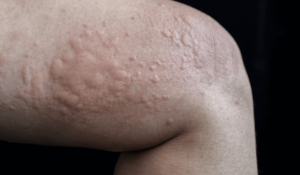
Urticaria, commonly known as hives, is a skin condition characterized by red, raised, itchy welts that can appear anywhere on the body. These welts may vary in size and shape, often merging to form larger areas of swelling.
Causes:
Urticaria can result from allergic reactions to foods, medications, insect stings, or latex. Non-allergic triggers include infections, stress, extreme temperatures, and certain physical stimuli like pressure or sunlight. In many cases, the exact cause remains unidentified.
Symptoms:
The primary symptom is the sudden appearance of welts that are red or skin-colored, accompanied by intense itching. These welts can change shape, move around, disappear, and reappear over short periods. Individual hives typically last less than 24 hours, but new ones may continue to develop.
Prevention:
To minimize the occurrence of urticaria:
Identify and avoid known allergens or triggers.
Manage stress through relaxation techniques.
Wear appropriate clothing to protect against extreme temperatures.
If hives persist for more than six weeks or are accompanied by difficulty breathing or swelling of the face and throat, seek immediate medical attention.
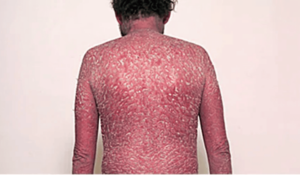
Psoriasis is a chronic autoimmune skin condition characterized by the rapid buildup of skin cells, leading to scaling on the skin’s surface. This overproduction of skin cells results in inflammation and redness around the scales, commonly appearing on the knees, elbows, trunk, and scalp.
Causes:
The exact cause of psoriasis isn’t fully understood, but it’s believed to involve a combination of genetic predisposition and environmental triggers. The immune system mistakenly attacks healthy skin cells, accelerating their life cycle and causing rapid accumulation on the skin’s surface.
Symptoms:
Psoriasis manifests as red patches of skin covered with thick, silvery scales. These patches may be itchy and sometimes painful. Common areas affected include the scalp, elbows, knees, and lower back. The severity varies from small, localized patches to complete body coverage.
Prevention:
Although psoriasis cannot be entirely prevented, certain measures can help reduce flare-ups:Avoid Triggers: Identifying and avoiding personal triggers, such as stress, infections, or certain medications, can help manage the condition.
Healthy Lifestyle: Maintaining a balanced diet, regular exercise, and avoiding smoking and excessive alcohol consumption can support overall skin health.
If you experience symptoms of psoriasis, consult a healthcare professional for an accurate diagnosis and personalized treatment plan.
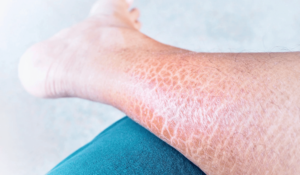
Ichthyosis is a group of skin disorders characterized by dry, thickened, and scaly skin, often resembling fish scales. It can be present at birth or develop later in life, varying in severity.
Causes:
Primarily, ichthyosis results from genetic mutations affecting skin cell regeneration and shedding. The most common form, ichthyosis vulgaris, arises from mutations leading to a deficiency in filaggrin, a protein essential for skin barrier function. In some cases, ichthyosis can be acquired due to underlying medical conditions such as kidney failure, certain cancers, or as a side effect of specific medications.
Symptoms:
Individuals with ichthyosis typically experience:
Dry, scaly skin: Accumulation of dead skin cells leads to rough, scaly patches, often on the arms, legs, and torso.
Itching and discomfort: The dryness and scaling can cause significant itching and discomfort.
Cracking and fissuring: Severe cases may result in painful cracks, increasing the risk of infections.
Overheating: Thickened skin can impair sweating, leading to difficulty in regulating body temperature.
Prevention:
While genetic forms of ichthyosis cannot be prevented, certain measures can help manage and reduce symptom severity:
Regular moisturizing: Applying emollients and moisturizers frequently helps maintain skin hydration and barrier function.
Gentle skin care: Using mild, fragrance-free soaps and avoiding hot water can prevent further drying of the skin.
Humid environment: Maintaining adequate humidity levels in living spaces can help prevent skin from becoming excessively dry.
If you suspect you have ichthyosis or experience persistent skin dryness and scaling, consult a healthcare professional for an accurate diagnosis and appropriate management strategies.
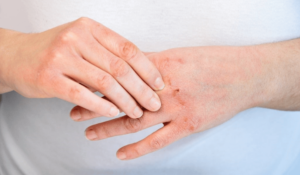
Chapped hands, characterized by dryness, redness, and cracking, often result from environmental factors and daily activities.
Causes:
Weather Conditions: Cold, dry air during winter months can strip moisture from the skin, leading to chapping.
Frequent Handwashing: Regular exposure to water and harsh soaps can deplete the skin’s natural oils, causing dryness.
Chemical Exposure: Handling detergents, solvents, or other chemicals without protection can irritate and dry out the skin.
Medical Conditions: Skin disorders like eczema or psoriasis can predispose individuals to chapped hands.
Symptoms:
Dryness: Skin feels rough and tight.
Redness: Inflammation leading to a reddish appearance.
Cracking: Severe dryness may cause the skin to crack, leading to discomfort or bleeding.
Itching or Burning: Irritated skin may itch or have a burning sensation.
Prevention:
Moisturize Regularly: Apply a quality hand cream multiple times daily, especially after washing hands.
Wear Protective Gloves: Use gloves when exposed to harsh weather or when handling chemicals.
Use Mild Soaps: Opt for gentle, fragrance-free soaps to minimize skin irritation.
Limit Hot Water Exposure: Wash hands with lukewarm water instead of hot water to prevent stripping natural oils.
If symptoms persist or worsen, consult a healthcare professional for further evaluation.
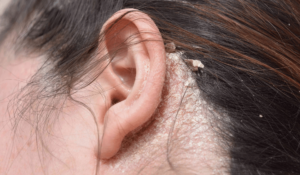
Seborrhea, commonly known as seborrheic dermatitis, is a chronic skin condition characterized by red, scaly, itchy, and inflamed skin. It primarily affects areas rich in oil glands, such as the scalp, face, and upper chest.Health
Causes:
The exact cause of seborrhea isn’t fully understood, but several factors may contribute:
Malassezia Yeast Overgrowth: A naturally occurring yeast on the skin that can proliferate excessively, leading to inflammation.
Excess Sebum Production: Increased oil production can create an environment conducive to yeast growth.
Genetic Predisposition: A family history of seborrheic dermatitis may increase susceptibility.Cleveland Clinic
Environmental Factors: Cold, dry weather and seasonal changes can trigger or worsen symptoms.
Stress and Fatigue: Emotional stress and physical exhaustion may exacerbate the condition.
Symptoms:
Common signs of seborrhea include:
Flaky Skin (Dandruff): White or yellowish flakes on the scalp, hair, eyebrows, or beard.
Red, Greasy Patches: Inflamed skin with a greasy appearance, often on the face, sides of the nose, eyebrows, ears, eyelids, and chest.
Itching or Burning Sensation: Affected areas may itch or feel uncomfortable.
Prevention:
To help prevent seborrheic dermatitis flare-ups:
Manage Stress: Engage in stress-reducing activities like meditation or exercise.
Maintain a Healthy Diet: A balanced diet supports overall skin health.
Practice Good Hygiene: Regular cleansing can help reduce oiliness and remove dead skin cells.
If symptoms persist or worsen, consult a healthcare professional for proper diagnosis and management.
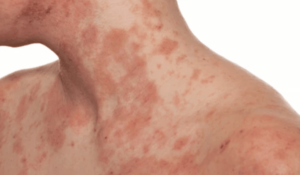
Pruritus, commonly known as itchy skin, is an uncomfortable sensation that prompts the urge to scratch. It can affect any part of the body and may occur without visible skin changes.
Causes:
Pruritus can result from various factors, including:
Dry Skin: Environmental factors like low humidity and excessive bathing can strip the skin of moisture, leading to dryness and itching.
Skin Conditions: Disorders such as eczema, psoriasis, and dermatitis often cause localized or generalized itching.
Allergic Reactions: Contact with allergens, including certain foods, medications, or plants like poison ivy, can trigger pruritus.
Parasitic Infestations: Conditions like scabies or lice infestations are known to cause intense itching.
Systemic Diseases: Underlying health issues such as liver disease, kidney failure, diabetes, or thyroid problems can manifest with generalized itching.
Neurological Disorders: Nerve-related conditions like multiple sclerosis or shingles may lead to pruritus.
Psychological Factors: Stress, anxiety, and other mental health conditions can contribute to the sensation of itching.
Symptoms:
The primary symptom of pruritus is an uncomfortable itch that may be accompanied by:
Redness: Inflamed areas of the skin.
Bumps or Blisters: Raised spots or fluid-filled lesions.
Dry, Cracked Skin: Especially common in cases of xerosis (dry skin).
Leathery or Scaly Texture: Skin thickening due to prolonged scratching or rubbing.
Prevention:
To minimize the risk of developing pruritus:
Moisturize Regularly: Applying moisturizers helps maintain skin hydration.
Use Gentle Skin Care Products: Opt for mild, fragrance-free soaps and detergents to reduce irritation.
Avoid Known Allergens: Steer clear of substances that have previously caused allergic reactions.
Maintain a Healthy Lifestyle: Proper hydration, a balanced diet, and stress management techniques can support overall skin health.
If itching persists for more than two weeks, is severe, or is accompanied by other concerning symptoms, consult a healthcare professional for an accurate diagnosis and appropriate management.
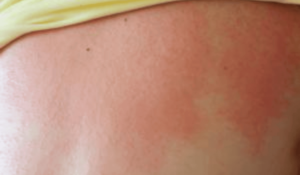
Heat rash, also known as prickly heat or miliaria, is a skin condition that occurs when sweat becomes trapped under the skin due to blocked sweat ducts. This leads to inflammation and the formation of small, itchy bumps.
Causes:
Heat rash develops when the body’s sweat glands become obstructed, preventing sweat from reaching the skin’s surface. This blockage can result from:
Hot and Humid Environments: Excessive sweating in warm climates increases the likelihood of clogged sweat ducts.
Physical Activity: Intense exercise or activities that induce heavy perspiration can contribute to duct blockage.
Tight or Non-Breathable Clothing: Garments that restrict airflow can trap sweat, leading to irritation.
Immature Sweat Ducts: Infants have underdeveloped sweat glands, making them more susceptible to heat rash.
Symptoms:
The presentation of heat rash varies depending on the depth of sweat gland obstruction:
Miliaria Crystallina: The mildest form, characterized by clear, fluid-filled blisters that break easily.
Miliaria Rubra (Prickly Heat): Marked by red bumps and a prickling or stinging sensation; this form is commonly associated with the term “prickly heat.”
Miliaria Profunda: A less common form where sweat leaks into the dermis, leading to firm, flesh-colored lesions.
These rashes typically appear on areas where sweat accumulates, such as the neck, chest, back, underarms, and groin.
Prevention:
To reduce the risk of developing heat rash:
Stay Cool: Utilize fans, air conditioning, and cool showers to maintain a comfortable body temperature.
Wear Appropriate Clothing: Opt for loose-fitting, lightweight garments made of breathable fabrics like cotton.
Limit Sweat-Inducing Activities: Avoid strenuous exercise during hot, humid conditions.
Keep Skin Dry: Regularly pat the skin dry to prevent moisture buildup.
If symptoms persist or worsen, consult a healthcare professional for further evaluation.
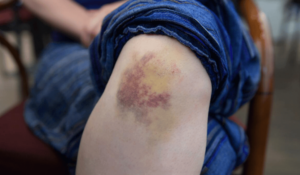
Ecchymosis, commonly known as a bruise, is a discoloration of the skin resulting from blood leaking into the tissues beneath the surface. Unlike minor bruises, ecchymosis typically presents as a flat, purplish area larger than one centimeter in diameter.
Causes:
Ecchymosis can arise from various factors, including:
Trauma: Blunt injuries that damage blood vessels without breaking the skin often lead to bruising.
Aging: As skin becomes thinner and blood vessels more fragile with age, even minor bumps can cause ecchymosis.
Medications: Blood thinners and certain anti-inflammatory drugs can increase bleeding risk, making bruising more likely.
Medical Conditions: Disorders affecting blood clotting or platelet function, such as hemophilia or thrombocytopenia, can result in frequent bruising.
Nutritional Deficiencies: Lack of vitamins C or K can impair blood vessel integrity and clotting, leading to increased bruising.
Symptoms:
The primary symptom of ecchymosis is a flat, discolored patch on the skin that changes color over time:
Initial Appearance: A red or purplish mark develops shortly after the injury.
Color Progression: Over days, the bruise may transition to blue, then green, yellow, and finally brown as the body breaks down and reabsorbs the blood.
Tenderness: The area may be sensitive or painful, especially when touched.
Swelling: In some cases, mild swelling can accompany the discoloration.
Prevention:
To minimize the risk of ecchymosis:
Protective Measures: Wearing appropriate safety gear during activities can help prevent injuries.
Home Safety: Removing tripping hazards and ensuring adequate lighting reduces the likelihood of falls.
Medication Management: Consult with a healthcare provider about the bleeding risks associated with certain medications.
Healthy Lifestyle: Maintaining a balanced diet rich in essential vitamins supports vascular health.
If bruising occurs frequently without apparent cause, is unusually large or painful, or is accompanied by other symptoms like bleeding gums or nosebleeds, it is advisable to seek medical evaluation to rule out underlying conditions.

Cuts, or lacerations, are injuries where the skin is sliced open, often exposing underlying tissues. They can vary in depth and length, depending on the cause and force of the injury.
Causes:
Cuts can result from various incidents, including:
Sharp Objects: Contact with knives, glass, or metal can easily penetrate the skin.
Falls: Landing on sharp or rough surfaces may cause the skin to break.
Accidents: Mishandling tools or machinery can lead to unintended cuts.
Symptoms:
Common signs of cuts include:
Bleeding: Severity depends on the depth and location of the cut.
Pain: Ranging from mild to intense, based on the injury’s extent.
Redness and Swelling: Inflammatory responses to injury.
Exposure of Tissues: Deeper cuts may reveal fat, muscle, or bone.
Prevention:
To reduce the risk of cuts:
Exercise Caution with Sharp Tools: Handle knives and other sharp instruments carefully.
Use Protective Gear: Wear appropriate equipment during activities with injury potential.
Maintain a Safe Environment: Keep living and workspaces free of hazards that could cause falls or injuries.
If a cut is deep, won’t stop bleeding, or shows signs of infection, seek medical attention promptly.
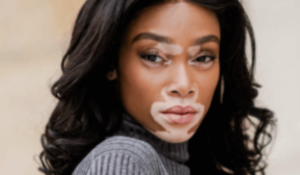
Vitiligo is a chronic skin condition characterized by the loss of pigment, resulting in white patches on various parts of the body. This depigmentation occurs when melanocytes, the cells responsible for producing skin color, are destroyed or cease to function.
Causes:
The exact cause of vitiligo remains unclear, but several factors may contribute:
Autoimmune Response: The immune system may mistakenly attack and destroy melanocytes.
Genetic Factors: A family history of vitiligo or other autoimmune diseases can increase susceptibility.
Environmental Triggers: Events such as sunburn, exposure to certain chemicals, or significant stress might initiate or exacerbate the condition.
Symptoms:
Vitiligo manifests as:
Depigmented Patches: White or lighter areas commonly appearing on the face, hands, arms, feet, and around body orifices.
Symmetrical Patterns: Often, the patches are symmetrically distributed on both sides of the body.
Premature Graying: Hair on the scalp, eyebrows, eyelashes, or beard may turn white or gray prematurely.
Mucosal Changes: Loss of color can also affect mucous membranes inside the mouth and nose.
Prevention:
While vitiligo cannot be entirely prevented, certain measures may help manage its progression:
Sun Protection: Regular use of sunscreen can protect depigmented skin, which is more susceptible to sunburn.
Skin Care: Avoiding skin trauma and using gentle skin-care products may reduce potential triggers.
Stress Management: Implementing stress-reduction techniques might help minimize flare-ups.
If you notice unexplained white patches on your skin, it’s advisable to consult a healthcare professional for an accurate diagnosis and discussion of management options.

Herpes infection is caused by the herpes simplex virus (HSV), which exists in two types: HSV-1 and HSV-2. HSV-1 primarily leads to oral herpes, manifesting as cold sores around the mouth, while HSV-2 is mainly associated with genital herpes. However, both types can infect either the oral or genital areas through direct contact.
Causes:
HSV is transmitted through direct contact with an infected individual’s skin or bodily fluids. Common modes of transmission include:
Oral Contact: Kissing or sharing utensils can spread HSV-1.
Sexual Contact: Engaging in vaginal, anal, or oral sex with an infected partner can transmit HSV-2.
Perinatal Transmission: An infected mother can pass the virus to her baby during childbirth.
Symptoms:
Many individuals with HSV may remain asymptomatic or exhibit mild symptoms. When symptoms do occur, they can include:
Painful Blisters or Ulcers: Fluid-filled lesions that break open and form sores, commonly around the mouth or genital area.
Itching and Tingling: Sensations often precede the appearance of blisters.
Flu-like Symptoms: Fever, body aches, and swollen lymph nodes, particularly during the initial outbreak.
Prevention:
To reduce the risk of HSV transmission:
Practice Safe Sex: Consistent use of condoms can lower, but not eliminate, the risk.
Avoid Direct Contact During Outbreaks: Refrain from kissing or sexual activity when sores are present.
Limit Sharing Personal Items: Do not share items like lip balm, utensils, or towels that may come into contact with sores.
If you suspect an HSV infection or experience recurrent symptoms, consult a healthcare professional for evaluation and guidance.
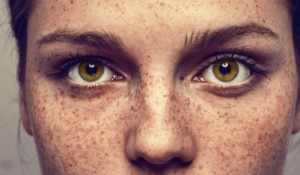
Freckles are small, flat, brownish spots that commonly appear on sun-exposed areas of the skin, such as the face, arms, and shoulders. They are generally harmless and result from an increased production of melanin, the pigment responsible for skin color.
Genetic Factors: Individuals with fair skin, red or blonde hair, and light-colored eyes are more prone to developing freckles. The melanocortin-1 receptor (MC1R) gene plays a significant role in their formation.
Sun Exposure: Ultraviolet (UV) radiation from the sun stimulates melanocytes to produce more melanin, leading to the appearance or darkening of freckles. They often become more prominent during the sunnier months.
Symptoms:
Freckles are characterized by:
Appearance: Small, flat, tan to light-brown spots, typically uniform in color.
Distribution: Commonly found on sun-exposed areas like the face, neck, chest, and arms.
Seasonal Variation: They may darken with increased sun exposure and lighten during periods of reduced sun exposure.
Prevention:
To minimize the development of freckles:
Sun Protection: Regularly apply broad-spectrum sunscreen with a high SPF to exposed skin, even on cloudy days.
Protective Clothing: Wear hats, long sleeves, and sunglasses to shield skin from direct sunlight.
Seek Shade: Limit time spent in direct sunlight, especially during peak UV radiation hours.
While freckles are typically harmless, any changes in their appearance or the development of new, irregular spots should prompt consultation with a dermatologist to rule out other skin conditions.

Molluscum contagiosum is a common, benign viral skin infection characterized by small, raised, pearl-like papules or nodules on the skin. These lesions are typically painless but may become itchy, sore, red, or swollen.
Causes:
The condition is caused by the molluscum contagiosum virus (MCV), a member of the poxvirus family. Transmission occurs through:
Direct Skin-to-Skin Contact: Touching an infected person’s lesions can spread the virus.
Contaminated Objects: Sharing items like towels, clothing, or toys that have been in contact with the virus.
Sexual Contact: In adults, molluscum contagiosum can be transmitted through intimate contact, classifying it as a sexually transmitted infection (STI).
Symptoms:
The hallmark of molluscum contagiosum includes:
Lesions: Small (2 to 5 millimeters), firm, dome-shaped bumps with a central dimple.
Color: Lesions may be white, pink, or flesh-colored.
Location: Commonly appears on the face, neck, arms, legs, abdomen, and genital area.
Itching or Discomfort: While usually painless, lesions can become itchy or irritated.
Prevention:
To reduce the risk of contracting or spreading molluscum contagiosum:
Practice Good Hygiene: Regular handwashing helps prevent infection.
Avoid Sharing Personal Items: Do not share towels, clothing, or other personal items.
Limit Direct Contact: Avoid touching lesions on yourself or others.
Safe Sexual Practices: Using protection can reduce the risk of sexually transmitted infections, including molluscum contagiosum.
While molluscum contagiosum is generally harmless and often resolves without intervention, individuals with weakened immune systems or those experiencing widespread or persistent lesions should consult a healthcare professional for evaluation.
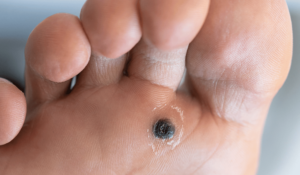
Warts are benign skin growths caused by the human papillomavirus (HPV), which infects the top layer of skin, leading to rapid cell growth and the formation of a wart.
Causes:
Warts are caused by certain strains of HPV. The virus can enter your skin through small cuts and cause extra cell growth.
Symptoms:
Warts can appear anywhere on the body and come in various forms:
Common Warts: Rough, raised bumps, often on hands and fingers.
Plantar Warts: Hard, grainy growths on the soles of feet, sometimes causing discomfort when walking.
Flat Warts: Small, smooth, flat-topped lesions, commonly on the face, arms, or legs.
Filiform Warts: Thread-like projections, typically around the mouth, nose, or neck.
Genital Warts: Soft growths in the genital area, transmitted through sexual contact.
Prevention:
To reduce the risk of developing or spreading warts:
Avoid Direct Contact: Do not touch warts on yourself or others.
Personal Hygiene: Keep skin clean and dry; avoid sharing personal items like towels or razors.
Protective Footwear: Wear shoes in public areas, especially in communal showers or pool areas.
Safe Practices: Use protection during sexual activity to reduce the risk of genital warts.
While warts are generally harmless, they can be bothersome or cosmetically concerning. If warts cause discomfort, spread, or persist, consult a healthcare professional for evaluation and management options.
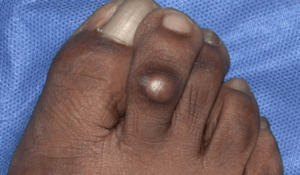
Corns are localized areas of thickened skin that develop due to repeated pressure or friction, commonly on the feet and toes. They are a protective response of the skin to prevent damage from continuous irritation.
Causes:
Corns form when the skin tries to protect underlying structures from excessive pressure or friction. Common causes include:
Ill-Fitting Footwear: Shoes that are too tight or have high heels can compress areas of the foot, leading to increased pressure.
Repetitive Activities: Actions that put consistent pressure on specific areas of the feet, such as running or walking long distances.
Toe Deformities: Conditions like hammertoes or bunions can cause abnormal pressure points inside shoes
Corns are characterized by:
Hardened, Raised Bumps: Small, round areas of thickened skin that may be yellowish in color.
Tenderness or Pain: Discomfort when pressure is applied, especially while walking or wearing shoes.
Flaky or Dry Skin: The surface of the corn may appear dry or scaly.
Prevention:
To reduce the risk of developing corns:
Choose Proper Footwear: Wear shoes that fit well, providing adequate room for toes and avoiding excessive tightness.
Use Protective Pads: Applying cushioned pads or insoles can help redistribute pressure away from vulnerable areas.
Maintain Foot Hygiene: Regularly moisturizing feet can prevent dry skin that may contribute to corn formation.
While corns are generally harmless, they can cause discomfort. If a corn becomes painful or shows signs of infection, it’s advisable to consult a healthcare professional for appropriate management.
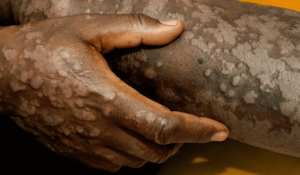
Tinea versicolor, also known as pityriasis versicolor, is a common fungal skin infection caused by an overgrowth of yeast that naturally resides on the skin. This condition leads to the development of discolored patches that may be lighter or darker than the surrounding skin.
Causes:
The yeast responsible for tinea versicolor thrives in warm, moist environments. Factors that can contribute to its overgrowth include:
Hot and Humid Climates: Living in or frequenting areas with high temperatures and humidity can promote yeast proliferation.
Excessive Sweating: Increased perspiration creates a favorable environment for yeast growth.
Oily Skin: Higher oil production can encourage yeast overgrowth.
Weakened Immune System: Individuals with compromised immunity may be more susceptible.
Symptoms:
Tinea versicolor manifests as:
Discolored Patches: These may appear white, pink, red, or brown and can be lighter or darker than the surrounding skin.
Location: Commonly found on the chest, back, neck, and upper arms.
Texture: Patches may be dry, scaly, and can sometimes cause mild itching.
Sun Exposure Effects: Affected areas may become more noticeable after sun exposure due to the contrast between tanned skin and the patches.
Prevention:
To help prevent tinea versicolor:
Maintain Skin Hygiene: Regular cleansing to remove excess oils and sweat can reduce yeast growth.
Wear Breathable Clothing: Opt for loose-fitting, natural fabrics to minimize moisture buildup.
Limit Sun Exposure: Protect skin from excessive sun to prevent patches from becoming more apparent.
Use Antifungal Products: During warmer months, using antifungal shampoos or body washes periodically may help prevent recurrence.
If you notice persistent or recurrent discolored patches on your skin, it’s advisable to consult a healthcare professional for an accurate diagnosis and appropriate management.
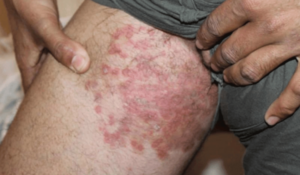
Tinea cruris, commonly known as jock itch, is a superficial fungal infection affecting the groin, inner thighs, and buttocks. It manifests as a red, itchy, and often ring-shaped rash, primarily occurring in adult men and adolescent boys.
Causes:
This condition is caused by dermatophyte fungi, such as Trichophyton rubrum, which thrive in warm, moist environments. Factors contributing to the development of tinea cruris include:
Excessive Sweating: Prolonged moisture in the groin area creates an ideal environment for fungal growth.
Tight or Irritating Clothing: Clothing that rubs or chafes can damage the skin, making it more susceptible to infection.
Obesity: Extra body weight can lead to increased sweating and skin folds, promoting fungal proliferation.
Weakened Immune System or Diabetes: Individuals with these conditions may have a higher risk of developing fungal infections.
Symptoms:
The primary symptoms of tinea cruris include:
Red, Itchy Rash: Typically located in the groin folds, inner thighs, or buttocks, often with a well-defined border.
Burning Sensation: Affected areas may experience discomfort or a burning feeling.
Flaking or Peeling Skin: The rash may be accompanied by scaling or peeling of the skin.
Cracking or Weeping Skin: In severe cases, the skin may crack or ooze.
Prevention:
To reduce the risk of developing tinea cruris:
Maintain Good Hygiene: Regularly wash the groin area with soap and water, especially after sweating.
Keep the Area Dry: Thoroughly dry the groin and inner thighs after bathing or exercise.
Wear Loose, Breathable Clothing: Opt for cotton or moisture-wicking fabrics to minimize moisture buildup.
Avoid Sharing Personal Items: Do not share towels, clothing, or other items that may harbor fungi.
Manage Other Fungal Infections: Treat conditions like athlete’s foot promptly to prevent the spread of infection to the groin area.
If you experience persistent or worsening symptoms, consult a healthcare professional for an accurate diagnosis and appropriate treatment.
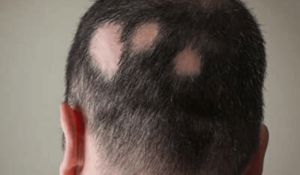
Alopecia is a condition characterized by hair loss, which can affect the scalp and other parts of the body. The severity and pattern of hair loss vary depending on the specific type of alopecia.
Types and Causes:
Androgenetic Alopecia: Also known as male-pattern or female-pattern baldness, this hereditary condition is influenced by hormonal factors and typically leads to gradual thinning of hair on the scalp.
Alopecia Areata: An autoimmune disorder where the immune system mistakenly attacks hair follicles, resulting in sudden, patchy hair loss.
Telogen Effluvium: A temporary condition often triggered by significant stress, illness, or hormonal changes, leading to widespread thinning of hair.
Traction Alopecia: Caused by continuous tension on the hair from tight hairstyles, leading to hair breakage and loss.
Anagen Effluvium: Rapid hair loss resulting from medical treatments like chemotherapy that impair hair follicle function during the growth phase.
Symptoms:
Symptoms vary but generally include:
Gradual Thinning: Especially noticeable on the top of the head in androgenetic alopecia.
Circular or Patchy Bald Spots: Common in alopecia areata.
Sudden Loosening of Hair: Hair may come out in handfuls due to telogen effluvium.
Full-Body Hair Loss: Occurs in conditions like alopecia universalis.
Prevention:
While not all forms of alopecia can be prevented, general measures include:
Gentle Hair Care: Avoid hairstyles that pull on the hair and minimize harsh treatments.
Balanced Diet: Ensure adequate intake of essential nutrients to support hair health.
Stress Management: Implement techniques to reduce stress, which can contribute to hair loss.
Medical Consultation: Discuss medications and supplements with a healthcare provider to identify potential side effects related to hair loss.
If experiencing unexplained or excessive hair loss, it is advisable to consult a healthcare professional for proper evaluation and guidance.
About Skin
Your skin is your body’s largest organ and the first line of defense against infections, pollutants, and harmful UV rays. But just like any other organ, it can develop problems that affect your appearance, comfort, and health. At Usmani’s Clinic, we believe early awareness and care can prevent long-term damage.
Skin problems include a wide range of conditions that affect the skin’s appearance, texture, or function. These may be temporary or chronic and can range from mild issues like acne to serious conditions like eczema, psoriasis, or skin cancer.
Causes of Skin Issues
Several factors can lead to skin problems:
- Genetics
- Hormonal Imbalance
- Poor Diet or Hydration
- Environmental Pollution
- Allergic Reactions
- Infections (bacterial, fungal, or viral)
- Stress and Lack of Sleep
- Incorrect Skincare Products
Symptoms of Skin Issues
Itching, redness, or inflammation
Rashes or bumps
Dry or flaky patches
Skin discoloration
Pimples or boils
Peeling or cracking skin
Changes in moles or spots
Treatments
Contact Us
- Shah Market Opp. PNB bank, Shahbad Gate, Rampur U.P 244901
- +91 99274 25447
- iinfo@drmyu.com
